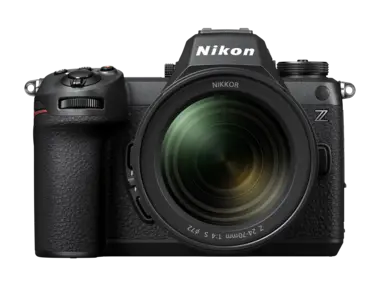Video terms decoded – a beginner’s guide

Don’t know your N-Log from your Pro-Res RAW? Never fear – read our handy guide to technical video language and upgrade your movies
Jumping into video creation can feel daunting. Even if you are a seasoned stills photographer, there’s a whole new set of terms to learn and understand. What are they? What do they mean? And how do they affect your output? Let’s look at some of the most used terms and demystify them.
Nikon Team
Aspect ratio
This is the ratio of width to height of the final footage. Most common are 16:9 widescreen (YouTube and TVs) and 9:16 for vertical video (TikTok, Instagram Reels, YouTube shorts etc). Others include 4:3 (the former standard for old CRT televisions), 21:9 (cinematic widescreen) and 1:1 (square).
Bit rate
This is the amount of data processed per second during video, expressed as Mpbs (megabits per second), for example, 8-bit, 10-bit or 12-bit. Higher quality resolution will usually have a higher bit rate. 10-bit or higher is normally for footage that would be edited on a high-powered computer.
Codec
A codec is an algorithm that compresses and decompresses video footage. This means it can be compressed to a small size to travel around the internet and then be decompressed when someone watches the footage on their screen. Popular codecs include H.264, which has been a standard for some time and offers compatibility across a range of platforms and devices, and the newer H.265, which creates smaller files but requires more processing power to edit and playback.
Colour space
A colour space is a collection of colour groupings that are supported by digital devices. These include RGB, commonly used in cameras and printers, Rec 709 and Rec 2020, which are used for High Definition and Ultra High Definition TVs, and DCI-P3, which is the industry standard for movies. The EVF in the Nikon Z6III is the first mirrorless camera to offer DCI-P3 compatibility.
Read more: World’s first in the Nikon Z6III
Frame rate
In stills shooting we have fps, or frames per second. In video, frame rate is denoted with a ‘p’, so frame rates are 30p, 60p, 240p etc, with p standing for ‘progressive scan’. The two are virtually interchangeable, but there will be some small differences in actual frame rate (24p is actually 23.973fps, for example). Frame rates are incredibly useful creative tools. Using 240p, for instance, gives you many more frames per second, making it ideal for creating slow-motion footage. Most feature films are shot at 24p, while TV sports with fast movement are often 60p for smoother action. In your Nikon Z menu you will find a host of different frame rates available to experiment with.
Full HD/4K/6K/8K
This is the resolution of the footage taken with the camera. The higher the resolution, the more detail captured (and the bigger the file). The advantage of higher resolution means the ability to crop in on a scene without losing detail. All Nikon Z cameras are capable of at least 4K resolution, while the Z6III can do 6K and the Z8 and Z9 can shoot up to 8K.
Grading
Colour grading is simply the creative process of manipulating colours in your footage to give you a ‘look’ that you want. You can go from dark and moody to bright and poppy, depending on what your story is saying and how you want viewers to feel and react to it. Taking video in either a log or RAW format is necessary here to give you maximum control over the final output.
HDR (high dynamic range)
This is a technology that expands the range of contrast and colour in footage, providing more detail in both shadows and highlights.
Log
At its most basic, log (or logarithmic) recording is a flat colour profile that’s a kind of halfway house between taking footage using presets that make it ready to go straight from the camera and shooting RAW. Using N-Log (Nikon’s own version of logarithmic recording specifically for Z cameras), you retain a vast amount of data that can be manipulated in post-processing, but where some things (such as White Balance and noise reduction) are fixed. The result is a great balance of manageable file sizes and the ability to manipulate your footage to get the desired result.
LUT (lookup table)
If you’re used to editing stills, LUTs are a bit like presets you might use in your stills editing software for colour grading to instantly get a look you like. As in editing stills, you can save your own settings as a LUT for future use. Exclusive LUTs developed by Nikon and RED, to give your footage a truly professional, cinematic look, are now available to download. Read more here.
RAW video
Filming RAW is the same as taking stills RAW – you are capturing all the data the sensor gets, giving you ultimate control over manipulation of the footage. There are different types of RAW file, such as ProRes RAW and Nikon’s N-RAW, which creates smaller (but still large) files. Mostly RAW video is used in professional set-ups where a lot of post processing will be required.
To record RAW footage from most cameras you will need a separate recording device attached to your camera, but some, such as the Nikon Z6III, Z8 and Z9, can record RAW in-camera. Beware, though, as RAW footage can eat up memory cards, so be prepared with spares – and you will need a lot of off-camera storage.
Shutter speed
Yes, you know what shutter speed is, but setting it in video is a crucial part of the creative process. Usually the standard rule to get the most natural effect is to have a shutter speed twice that of your frame rate. So, for example, if you are shooting at 25p then the shutter speed would be set at 1/50. Slowing down your shutter speed will give you motion blur effects in your footage, like a long exposure still, while a fast shutter speed will accentuate sharpness for fast-moving scenes. Slowing down shutter speed can also help to avoid flicker from LED and fluorescent lighting.
T-stop
Aperture on specialist (and very expensive!) cinema lenses is measured in T-stops rather than F-stops. What’s the difference? F-stops are measured at the iris of the lens, but don’t take into account the glass lens elements between the iris and the sensor that might soak up a little of that light. This means that two f/2.8 lenses with the same focal length from different manufacturers will actually have slightly different amounts of light landing on the sensor. T-stops, on the other hand, are direct, tested measurements of light that is transmitted through the lens (the T is for transmission). This means no matter what lens you use, the same T-stop will always let the exact same amount of light arrive at the sensor. This is important for big budget productions with multi-camera set-ups, where each camera needs to have exactly the same exposure.
More in Videography

Unlock greater creativity







